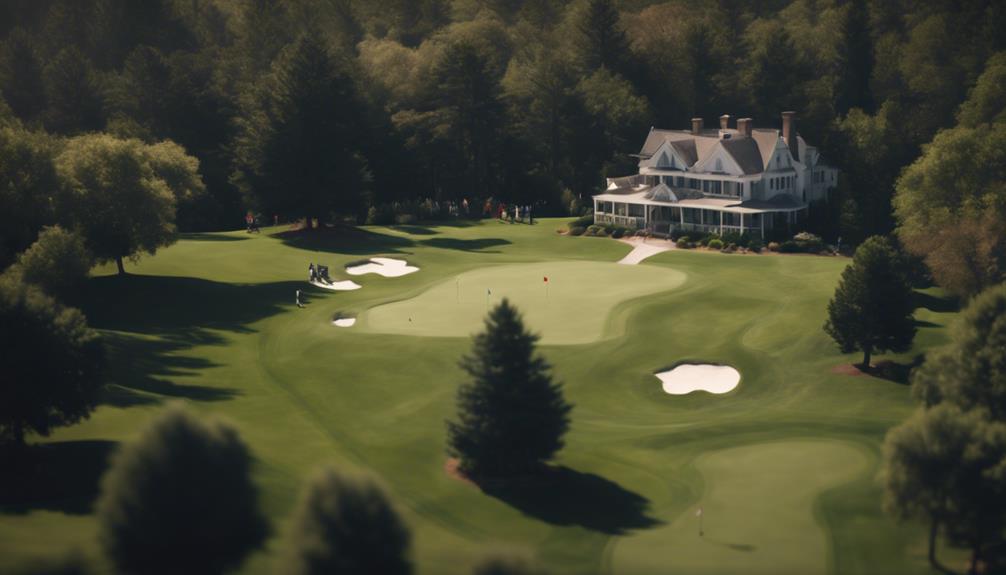- 7 Top Flite Golf Clubs XL for Improved Performance - September 28, 2024
- Top Flite Golf Clubs: Top 5 Reasons to Choose Them - September 28, 2024
- Top 3 Golf Club Fitters for a Perfect Swing - September 28, 2024
You'll step onto a golf links course, characterized by sandy soil, natural elements like dunes and pot bunkers, and uneven fairways that challenge your accuracy and course management skills. This traditional, often windy, terrain requires strategic adjustments to navigate undulating terrain and precise shot placement to overcome obstacles. As you take on the links, you'll appreciate the rich history tied to the Open Championship, and now, you're one step closer to revealing the secrets of this unique golfing experience, where every shot counts, and every nuance matters.
Key Takeaways
- A links golf course is characterized by sandy soil, natural elements, and minimal tree cover, often located near the coast.
- Links courses typically feature dunes, pot bunkers, and uneven fairways, requiring strategic adjustments and accurate play.
- The wind plays a significant role in links golf, making it essential to consider wind direction and speed when selecting shots.
- Links courses often have a rich history, with many tied to the Open Championship, offering unique golfing experiences.
Understanding Links Golf Courses
Exploring the unique characteristics of links golf courses reveals a distinct playing environment that challenges golfers to adapt to its rugged, coastal landscape.
As you step onto the course, you'll notice the sandy soil that allows for excellent drainage and firm playing surfaces year-round. The term 'links' originates from the Scottish word 'hlinc,' referring to rising ground, and true links courses feature natural elements like dunes, pot bunkers, and minimal tree cover.
When playing on a links course, you'll quickly realize that wind plays a significant role, requiring you to adjust your game strategy. Uneven fairways and pot bunkers add to the challenge, making accuracy and strategic course management essential.
To master links golf, you'll need to develop a solid understanding of the unique conditions and adapt your game to navigate the coastal terrain. With a rich history tied to the Open Championship, links golf courses offer a unique and rewarding experience for golfers seeking to test their skills.
Historical Significance and Iconic Courses
As you explore the rich history of links golf, you'll discover that its roots are deeply entrenched in Scotland, where the game originated on common land unsuitable for farming. This unique coastal location has given birth to some of the most iconic courses in the world, boasting a rich historical significance that's unparalleled in the golfing world.
Some of the most revered links courses include:
- The Old Course at St. Andrews, recognized as the 'Home of Golf'
- Royal Birkdale Golf Club, which has hosted The Open Championship 10 times
- Royal Portrush Golf Club in Northern Ireland, the only course outside Scotland and England to host The Open
These iconic courses not only test golfers' skills but also reflect Scotland's rich golf heritage, with many historic courses still in play today.
The Open Championship, the oldest major championship in golf, has been primarily held on links courses, further solidifying their significance in the golfing world.
As you investigate deeper into the world of links golf, you'll appreciate the nuances and challenges that make these courses truly special.
Maintenance and Environmental Considerations

When maintaining links courses, you'll find that a delicate balance must be struck between preserving the natural beauty of the landscape and guaranteeing a functional golf play experience, with minimal irrigation and skilled labor required to preserve natural hazards like dunes and pot bunkers.
To achieve this balance, links course maintenance emphasizes naturalization efforts, including the planting of native vegetation and the removal of invasive species to protect coastal ecosystems. This approach also helps to maintain the course's natural aesthetics, as native vegetation blends seamlessly into the surrounding landscape.
Here's a breakdown of the key maintenance considerations for links courses:
| Aspect | Description | Impact |
|---|---|---|
| Irrigation | Minimal due to sandy soil | Excellent drainage, firm ground |
| Natural Hazards | Preserved through skilled labor | Maintains beauty, playability |
| Vegetation | Native species planted, invasives removed | Protects coastal ecosystems, maintains aesthetics |
| Resources | Limited, reflecting historical reliance | Basic machinery, limited staff |
| Aesthetics | Balanced with playability considerations | Guarantees functional golf experience |
Gameplay Strategies and Tips
To optimize your gameplay on a links course, you must adapt your strategy to account for the unique challenges presented by the firm, fast, and undulating terrain, which demands precision and control over brute power. This requires a thoughtful approach to shot selection, taking into account factors like wind direction and speed.
Here are some key considerations to keep in mind:
- Prioritize accuracy and distance control, as the firm fairways reward precise shot placement over raw power.
- Utilize the bump-and-run technique to navigate the undulating terrain and minimize the impact of wind and slope.
- Familiarize yourself with the layout, including specific hazards and complex green designs, to develop a strategic approach tailored to the course.
Planning a Trip and Membership Benefits

You'll want to carefully plan your trip to a links course, taking into account factors like accommodations, tee time reservations, and membership benefits that can elevate your overall experience. Booking a stay near the course allows you to fully immerse yourself in the golfing experience and explore local attractions, regional cuisine, and natural beauty.
Tee time reservations are essential, so be sure to book well in advance to secure your preferred slots.
Membership at a links golf club can bring exclusive perks, such as access to top courses, discounts on gear, and opportunities to network with fellow enthusiasts. Many clubs offer tailored membership packages that include special access to events and promotions, making membership even more appealing.
Frequently Asked Questions
What Defines a Links Golf Course?
You'll discover that a links golf course is defined by its traditional design, situated on coastal terrain with sandy soil, featuring natural hazards like rolling dunes, and demanding wind conditions that test your skills on unique turf types.
Are All Links Courses by the Sea?
You might assume all links courses are by the sea, but that's not the case; in reality, they can exist inland, replicating coastal characteristics like sandy turf, undulating fairways, and strategic layouts, without being tied to coastal geography.
Why Is It a Links Course?
You're playing on a links course because it embodies traditional design, leveraging coastal terrain to create wind challenges, while sandy soil and natural hazards test your skills amidst native grasses, reflecting its historical significance and minimalist approach to golf evolution, demanding strategic play.
What Does Links Play Mean in Golf?
As you step onto the rugged, windswept terrain, you realize links play means adapting your golf strategy to course conditions, mastering turf management, and making precise shot selections to counter wind effects, demanding player skills, and testing your game pace in tournament formats steeped in historical significance.
Conclusion
As you step off the links, you've experienced the essence of golf's heritage.
With a deeper understanding of these unique courses, you're now equipped to tackle the challenges of the game.
Did you know that the average links course requires 70% less water than a traditional parkland course?
This staggering statistic highlights the environmental benefits of links golf, making it a sustainable option for the future of the game.




